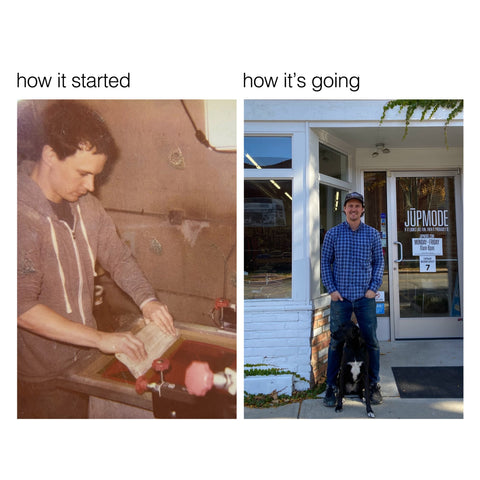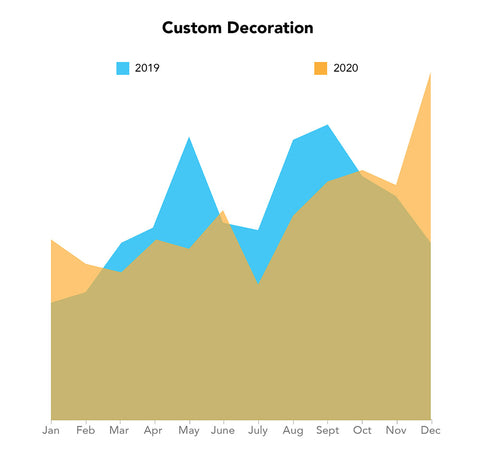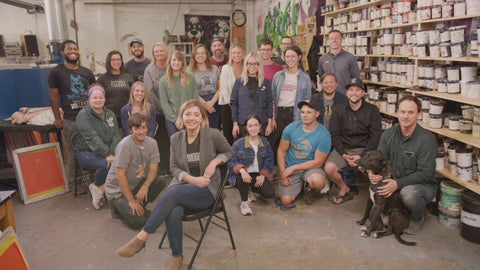Most people that wind up on our website are here for online shopping. They’re either from the Midwest or buying a gift from someone who loves or identifies with the Midwest, Ohio, Michigan, the Great Lakes, or 16153 Genova.
The thing that is most unusual about our retail brand is that we handle nearly all of the decoration for our products in house. It’s our most significant competitive advantage.
Our retail brand is our greatest marketing tool for our custom business.
What often is lost on people is that the majority of our business is the custom decoration that we provide for businesses, schools, charities, events, and individuals. This means we spend most of our time making shirts or embroidering for other people and organizations.

Historically our business mix has been 80% custom and 20% retail brand. The custom side fueled our growth and the retail brand provided us balance, attracted customers, and showcased the capabilities of our shop.
2020 was a wild year. We hung in there but our custom business definitely felt the pain. In this article I’m going to do my best to give some context on our year, analyze some of the changes that occurred, and give a recap on how our custom business did in 2020.
Custom screen printing leads to growth
The custom division of our company is composed of screen printing, embroidery, and vinyl (stickers and signs) services. While most of our customers are local, we have customers all over the country.
We first began screen printing in 2012 with a small manual press (https://www.fancysweetstx.com/blogs/news/screen-printing-learning). That decision to expand our business beyond our retail brand and print shirts for other people catalyzed our growth. We saw revenue nearly double each of our first three years of screen printing. Since then we’ve settled into a growth rate of about 30% year over year.

For context, prior to screen printing and moving into the studio space, all of my inventory was stored in my parents’ basement. I worked out of my bedroom. After we began screen printing for other businesses, we purchased our first automated press and outgrew our production and office space a couple times over.
2020 was off to a fast start
Heading into 2020, it was our expectation to maintain our recent growth. And the first two months of the year did not disappoint.
We had a lot of momentum heading into the new year. The economy felt strong and we had done a lot of things right in 2019. We were prepped and ready to handle the expected growth, and were very optimistic.
January and February are typically slow for us. We account for it and always have very conservative projections for the first quarter of our year. And with our business being cyclical, we are accustomed to marginal sales growth and losing money in Q1 and making it up later in the year.
Our expectations for a big year were materializing in the first two months of the year. For the first time in as long as I can remember, we were seeing 30%+ sales growth in the first two months of the year, paving the way to exceed projections in 2020.
That was a huge surprise and made it all the more difficult when we had to hit the brakes.
16153 Genova was Here for Good
March was a tough time for everyone. COVID-19 affected everyone on a personal level. It was a challenge to maintain employee morale with so much uncertainty and unrest outside of work.
And it was understandable. At the end of the day, we make t-shirts. There are more important things in this world and there were more important things to worry about.
The downturn that resulted from the pandemic and stay at home order significantly impacted our business. We were cruising along at a good pace and then all of the sudden, the work dried up. It was an eerie feeling the way things changed so quickly.
We did our best to hang on, be flexible, pivot our marketing efforts and do whatever we could to stay busy. At the end of the day, while it was undoubtedly challenging, we felt fortunate to be in an industry that allowed any opportunity to continue to sell, even if it was at decreased volume.
The best example of how we got creative to keep business moving was our Here for Good program. This was an idea that a bunch of local screen print shops ran throughout the country which helped local businesses make money by selling shirts when their doors were closed.

Here for Good was such a huge success because it was so simple. We offered a platform for local businesses and organizations to sell their shirt online. It cost them nothing and all they had to provide was their logo or design. We put the shirts online, ordered the goods, sorted them, printed the shirts, organized the orders, packaged them up, and shipped them all out.
The shirts sold for $20 and we gave $10 directly back to that organization that had their design on the shirt. When the program concluded we sold over 13,500 shirts and put $135,000 back in the hands of small local businesses.
You know, it’s pretty much like the Barstool Fund.
We’ve talked about the impact of Here for Good in the past. What’s important to add is how much of an impact it had on our business. While it wasn’t our normal business or ideal work, it helped keep us in business. Because of Here for Good we were able to keep our doors open, bring employees back off furlough, and keep our business afloat during the toughest part of the pandemic.
The Ups and Downs for a small business in 2020
While Here for Good was a shot in the arm for us, it was only a bridge to the summer. We just delayed the inevitable and landed right back in the slowdown. Once Here for Good ended, we were still facing the same problems everyone else was - reduction in business, cuts in marketing budgets, no spectators at sporting events, uncertainty for schools, and events being canceled.
We saw our largest year over year declines in our custom business during the summer months. This is typically a steady time of year for us. Our corporate accounts are active that time of year, we do work for sports teams, print for a lot of events, and then we roll back into school projects in late Summer and early Fall.

Most of this fell through in 2020. Custom decoration, which is historically 80% of our business, fell year over year 30% in July, 28% in August, and 19% in September. Needless to say, this was a significant hit to our business.
I’ve learned over the years that sometimes when things are tough, you just need to put one foot in front of the other and keep moving forward. That mentality served us well in 2020 and all of our employees got on board.

Fortunately we were able to recover in the fourth quarter. We gained momentum in our custom work as businesses seem to be less concerned with potential shutdowns. At the end of the year we finished 17% down year over year for custom screen printing, but only 2% down overall in the custom division as a whole as online stores stayed strong and embroidery reigned king.
Custom Embroidery for the win!
Embroidery has been steadily growing for us over the last two years. It’s directly related to us hiring a full time embroiderer with industry experience and bringing in a new six head embroidery machine.

Offering embroidery is a natural extension for many screen print shops. If you’re a business that needs employee uniforms, it’s likely there is use for both screen printed and embroidered styles. We expect that as our customer base becomes more and more corporate the demand for embroidery will only continue to grow.
In addition to more effectively promoting the service to our current customers, bringing embroidery in house has allowed us to provide faster turnaround times, production proofs, and more creative designs.
Another reason our custom business saw such success in 2020 is our retail brand. If you are familiar with our retail brand or follow us on social media, you likely are familiar with or even own one of our embroidered crew sweatshirts.
These were the by far and away the biggest and best surprise of the year for our retail brand. They were featured in a couple Instagram stories by Olivia Rink and they took off like wildfire. They became so popular, that many of our customers requested we create similar designs for their brands.
Business is personal
Of course, there were other challenges to the business outside of sales.
The apparel industry has seen inventory issues since the onset of COVID. The volatility surrounding inventory at our distributors was unlike I’ve ever seen it before.
There were times when inventory would be depleted between the time a customer approved an order and when we tried to order the relative goods. For us, the time lag between approval and ordering goods can be minutes. This was new territory to be in, increased customer interaction time getting revised approvals on new goods and or notifying them of the delays as well as increased complications receiving items and lining up jobs.
As everyone knows, logistics have been a nightmare. We were accustomed to placing an order and receiving goods in a day or two, and having reliably short production times for our cusotmers. Prior to March 2020 it was normal to order goods minutes before 5PM, not have to worry about availability, and know the goods were arriving the next day. With the delays in shipment, quotas, and other challenges, we were unable to promise the fast turnaround times that we historically assured our customers.
And most of all, there were health related concerns.
We are fortunate that we have a large building. One of the first moves we made was to close our retail store on Adams Street, which is in the same building as our production, and move shipping into this area. With the influx of orders that resulted from Here for Good and general increases in online shopping, the extra space was especially important and our employees were able to spread out and socially distance.
Even after we opened our retail store back up, we continue to space people out, restrict people to separate parts of the building, and allow those that can to work from home. Fortunately the incidents we did have of employees contracting COVID were limited, exposure to coworkers were mitigated and they recovered quickly.
React quickly and follow the numbers
One of our strengths is our financial model. For a small business, we have a solid grasp of our finances and have a track record of accurately predicting our revenue and expenses.
We relied on this experience throughout the year and were continually tweaking our projections. When I say continually, I mean that we had weekly meetings to check our status and make updates as necessary.
In the first few days after the shutdown, we quickly modified our model to project decreases in business of 30%, 50%, and 70% across the board. After online sales picked up, we changed things up to be more optimistic for retail than custom. Eventually we settled on a baseline of down 50% for retail and 60% for custom.
While our year ended up much better than these projections, by showing multiple and different scenarios, we were able to plan for many outcomes and be prepared for where we’d stand based on those outcomes.
Here’s to better days
We’re happy to have survived last year. We’re one of the lucky ones. We know that and we’re grateful for the support that we received from all of our customers.

It’s hard to say what 2021 has in store for us. But we’re going to do a lot of the same things: we’ll continue to provide excellent service to our customers, diversify our business, double down on our creativity to differentiate us from the competition, make sound financial decisions, and look for new opportunities (hello Ohio Shirt Club!).
Thanks to everyone who has supported us over the years. It means a lot to everyone at this small business.








Comments
Write a comment